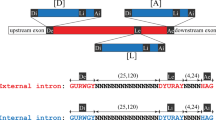Abstract
On the basis of available nucleotide sequence and genetic data, we present a model for RNA splicing in fungal mitochondria. Seven intron RNAs of two fungal species can form identical secondary structures, involving four conserved sequences, which bring the ends of each intron together and allow an internal guide RNA sequence to pair with exon bases adjacent to the splice junctions. The splicing sites are thus aligned precisely within a conserved structure, which we suggest could present specific recognition signals to the proteins that catalyse the splicing reaction.
This is a preview of subscription content, access via your institution
Access options
Subscribe to this journal
Receive 51 print issues and online access
$199.00 per year
only $3.90 per issue
Buy this article
- Purchase on SpringerLink
- Instant access to full article PDF
Prices may be subject to local taxes which are calculated during checkout
Similar content being viewed by others
References
Borst, P. & Grivell, L. A. Nature 285, 439–440 (1981).
Waring, R. B. et al. Cell 27, 4–11 (1981).
Davies, R. W. et al. in Mitochondrial Genes (eds Borst, P., Attardi, G. & Slonimski, P. P.) 405–410 (Cold Spring Harbor Laboratory, New York, 1982).
Fox, T. & Leaver, C. J. Cell 26, 315–32 (1981).
Waring, R. B., Davies, R. W., Scazzocchio, C. & Brown, T. A. Proc. natn. Acad. Sci. U.S.A. 79, 6332–6336 (1982).
Bonitz, S. G. et al. J. biol Chem. 225, 11922–11926 (1980).
Nobrega, F. G. & Tzagoloff, A. J. biol. Chem. 255, 9829–9837 (1980).
Dujon, B. Cell 20, 185–197 (1980).
De La Salle, H., Jacq, C. & Slonimski, P. P. Cell 28, 721–732 (1982).
Lamouroux, A. et al. in The Organisation and Expression of the Mitochondrial Genome (eds Kroon, A. M. & Saccone, C.) 153–155 (Elsevier, Amsterdam, 1980).
Lazowska, J., Jacq, C. & Slonimski, P. P. Cell 22, 333–348 (1980).
Netter, P., Jacq, C., Carignani, G. & Slonimski, P. P. Cell 28, 733–738 (1982).
Jacq, C. et al. in Mitochondrial Genes (eds Borst, P., Attardi, G. & Slominski, P. P.) 155–183 (Cold Spring Harbor Laboratory, New York, 1982).
Rogers, J. & Wall, R. Proc. natn. Acad. Sci. U.S.A. 77, 1877–1879 (1980).
Lerner, M. R. et al. Nature 283, 220–224 (1980).
Bos, J. L. et al. Cell 20, 207–214 (1980).
Dieckman, C. L., Pape, L. K. & Tzagoloff, A. Proc. natn. Acad. Sci. U.S.A. 79, 1805–1809 (1982).
Lamb, M. R. et al. J. biol. Chem. (in the press).
Schmelzer, C. & Schweyen, R. J. Nucleic Acids Res. 10, 513–524 (1982).
Michel, F., Jacquier, A. & Dujon, B. Biochemie (in the press).
Lazowska, J., Jacq, C. & Slonimski, P. P. Cell 27, 12–14 (1981).
Author information
Authors and Affiliations
Rights and permissions
About this article
Cite this article
Davies, R., Waring, R., Ray, J. et al. Making ends meet: a model for RNA splicing in fungal mitochondria. Nature 300, 719–724 (1982). https://doi.org/10.1038/300719a0
Received:
Accepted:
Issue Date:
DOI: https://doi.org/10.1038/300719a0



